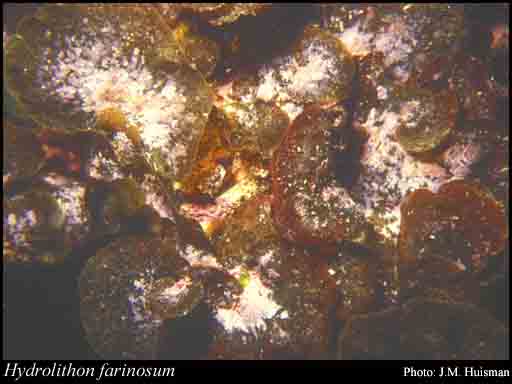- Reference
- Phycologia 32:295 (1993)
- Conservation Code
- Not threatened
- Naturalised Status
- Native to Western Australia
- Name Status
- Current

Scientific Description
Habit and structure. Thallus encrusting, epiphytic and affixed by cell adhesion. Structure pseudoparenchymatous; organisation dorsiventral; construction dimerous, consisting of a single ventral layer of branched filaments composed of non-palisade cells, and unicellular or multicellular simple or branched filaments that arise more or less perpendicularly from cells of ventral layer filaments, each filament composed of cells 5–20 µmin diameter and 5–30 µmlong; epithallial cells terminating most filaments at the thallus surface, distal walls rounded or flattened but not flared; cells of adjacent filaments joined by cell-fusions, secondary pit-connections absent; trichocytes present or absent, if present, usually occurring singly at thallus surface, not becoming buried within thallus.
Reproduction.Vegetative reproduction by propagules. Gametangia, carposporangia, tetrasporangia and bisporangia produced in uniporate conceptacles. Gametangial plants monoecious; carpogonia and spermatangia produced in separate conceptacles. Carpogonia terminating 3-celled filaments arising from the female conceptacle chamber floor. Mature female-carposporangial conceptacle roofs protruding above or flush with surrounding thallus surface, composed of 2 or 3 cells above the chamber, conceptacle chambers 110–125 µm in diameter and 100–120 µm high. Carposporophytes developing within older female conceptacles after karyogamy, when mature composed of a large central fusion cell and gonimoblast filaments bearing terminal carposporangia. Spermatangial filaments unbranched, arising from the floor of male conceptacle chambers, mature male conceptacle roofs protruding above surrounding thallus surface, conceptacle chambers 60–85 µm in diameter and 40–55 µm high. Tetrasporangial and bisporangial conceptacle roofs protruding above surrounding thallus surface, 2 or 3 cells thick above the chamber, pore canals lined with non-protruding cells, conceptacle chambers 100–140 µm in diameter and 85–105 µm high; tetrasporangia and bisporangia usually peripheral to a central columella, sometimes scattered across the conceptacle chamber floor, mature sporangia zonately divided.
Distribution.British Isles; France; Greece; Florida; Indonesia; Kenya; the Persian Gulf; the Red Sea; South Africa; Spain and tropical W. Aust. In southern Australia, Point Westall, S. Aust. to Sorrento, Vic.
Habitat. H. farinosum is found commonly on various algae and on the seagrass Amphibolis antarctica.
[After Womersley, Mar. Benthic Fl. Southern Australia IIIB: 260–261 (1996)]
Distribution
- IMCRA Regions
- Leeuwin-Naturaliste.
- Local Government Areas (LGAs)
- Broome, Rockingham.